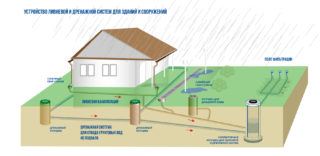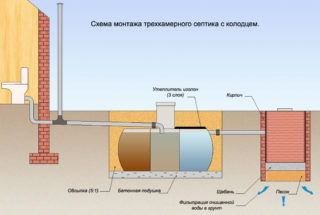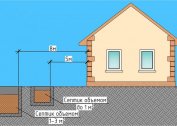The drainage system in a private house provides for the presence of three types of wastewater - sewage, storm and drainage. In the first place in relevance is sewerage - it drains sewage into a septic tank. It is also impossible to do without a drainage system, otherwise the appearance of the building will soon change for the worse due to the constant exposure to rain and snow. Subflooding and destruction of the foundation is possible if the groundwater is also high. If there are basements - a garage, a workshop, a gym - you need to think about waterproofing and laying drainage pipes with the possibility of water drainage outside the site.
The drainage device in a private house
 Two types of drainage systems are planned at the construction stage of the house - this is drainage and sewage. Gutter rainwater is easier to equip, so it is left for the final stage of construction.
Two types of drainage systems are planned at the construction stage of the house - this is drainage and sewage. Gutter rainwater is easier to equip, so it is left for the final stage of construction.
Do-it-yourself water drainage in a private house can be done in different ways:
- combine rainwater with a drainage system and divert into a river or lake, if any are nearby;
- equip a septic tank for each system, while water can be used to water the garden in the summer;
- make a common system, but dig a few wells: one of them for a settling tank with solid waste, the second and third as filter fields with an open bottom, where the liquid will be absorbed into the soil as it arrives.
Sewer pipes are usually laid in soil below the level of soil freezing in a particular region, the features of which can be found out from local architects or ordinary builders.
Stormwater is not laid so deep. The system is a complex of trays dug in flush with the soil along which the fluid moves to its place of storage.
Drainage is a deep or surface system that needs to be organized around the building if there are basements. The surface drainage system is often connected to the storm to save materials.
Without a drainage system, with a high level of groundwater and heavy soil type, the plants on the site will suffer from a lack of oxygen - their root system will rot, especially on clay soil or loam. Sandy soils or sandstones absorb liquid faster, so you can combine highways and bring water to aeration fields through perforated pipes.
Design of sewage systems
 When constructing a house, all three drainage communications are included in the plan, or two - at the choice of the owner. If the budget allows, you need to make three separate systems with different possibilities of liquid output into a reservoir, ditch, septic tank or centralized sewage system.
When constructing a house, all three drainage communications are included in the plan, or two - at the choice of the owner. If the budget allows, you need to make three separate systems with different possibilities of liquid output into a reservoir, ditch, septic tank or centralized sewage system.
Sewerage Design
Sewerage internal and external is planned separately. The materials used for internal wiring are usually not as durable as those required for outdoor conditions.
In the internal system, it is important to correctly slope the pipes and calculate their diameter depending on the number of residents and points where water is consumed, and also remove the fan pipe for venting the sewage system.
For the external highway, there are much more requirements and wishes:
- level of occurrence of pipes;
- their diameter with separate planning of drains and a combined system;
- the number of turns of the highway - the smaller the better, otherwise you will have to invest in the arrangement of inspection wells;
- insulation or heating of the trunk;
- pressure or non-pressure type, depending on whether it is possible to make a bias in the direction of the septic tank.
The choice of design of a septic tank - one, two or more - depends on what average amount of effluent enters the sump, whether it is combined with the rest of the mains or not.
Storm Design
It is easier to make a drainage system on the house itself, but where to install the trays - on the surface of the ground or underground - depends on the budget at the time of construction. If you immediately make an underground bookmark, you will have to give more money for materials and work, but then you can no longer return to this issue.
If necessary, save, the removal of rainwater from the foundation of the house can be done by yourself later. The advantage of underground bookmarking trays is that they will not take up extra space. With a small area of the site, it matters. Observation shafts can be equipped on flower beds and improve the appearance of the territory. It is rarely necessary to clean, as debris lingers on the gratings of the gutters located under the roof.
Overhead trays are easier to clean from debris, as they are covered with grates. Once a year, the grates are lifted and thoroughly cleaned.
Drainage system design
The drainage system is one of the most difficult in design, since it is necessary to decide where the pipe will go in relation to the house. If the groundwater level is high, you need a whole system of trays, pipes or devices for the targeted collection of liquids, followed by their removal from the territory.
DIY installation methods
 The use of plastic products - pipes, septic tanks, gutters and trays - greatly facilitates the independent installation of highways. The hardest work is digging a pit under a sump. Lightweight lines can be assembled and laid independently. When using heavy concrete rings, you will have to invite equipment and helpers.
The use of plastic products - pipes, septic tanks, gutters and trays - greatly facilitates the independent installation of highways. The hardest work is digging a pit under a sump. Lightweight lines can be assembled and laid independently. When using heavy concrete rings, you will have to invite equipment and helpers.
Popular ways to make a sewer for a private house:
- highway from plastic, septic tank from concrete rings;
- all elements of external wiring and septic tank made of plastic.
Concrete is a durable material that will last a long time. If desired, you can make two compartments connected by a pipe. In the first, large particles will settle, when overflowing, dirty water will flow into the next septic tank. Usually, the first is done with a closed bottom, so as not to pollute the site and groundwater with waste, the second has a drainage pad of gravel or sand. The type of soil should be considered here. Clay does not absorb water well and overflows of dirty liquid into the garden or flowerbed are possible. The presence of a layer of sand facilitates the selection of a septic tank design - it can be done with an open bottom. Some craftsmen divert perforated pipes underground from the second tank in different directions to increase the area of the filtration fields.
Drainage and storm systems are combined or made separately. With a small average annual rainfall, but a high level of groundwater, they can be combined and sent to a separate septic tank. If there is a lot of rain and snow all year round, it is better to make both highways separately. Since light materials are used during installation, it is not difficult to lay them on their own. It is important here to observe the bias of the wiring in the direction of the septic tank so that the liquid does not stagnate in the pipes.
Errors in the installation and design of drainage systems
There are SNiP standards for the design of drainage systems. First of all, this concerns the location of the septic tank relative to housing and a drinking well. If you make them too close, you will have to install filters, since the water will have a high content of organic substances and household chemicals.
The second mistake is non-compliance with the slope of the pipe. This can lead to fluid backflow. In this case, you will have to install a sewage pump to force drains into the septic tank forcibly.Lack of slope can cause damage to the line due to the formation of an ice plug inside. In this case, it will be impossible to use the sewage system before the onset of heat.
Incorrect pipe diameter calculations in internal and external wiring. If the throughput of a sewer, storm or drain pipe is less than the number of drains, stagnation will occur in the bathroom, sinks.
It is advisable to design the external sewer in a straight line, then there is no need to install inspection wells throughout the site to control the bends of the highway. It is impossible without them, because it is precisely in the places of pipe turns in pressureless sewers that blockages most often occur, which can be cleaned by digging all the pipes.


